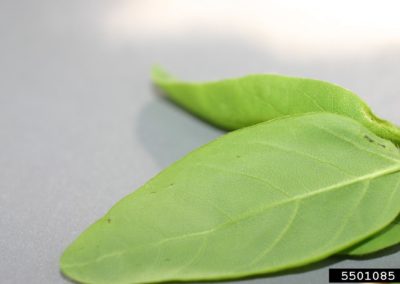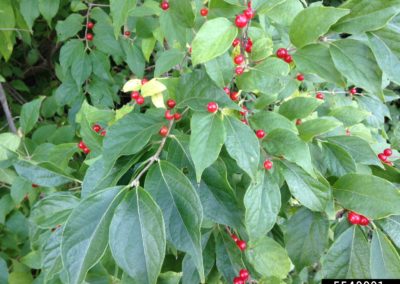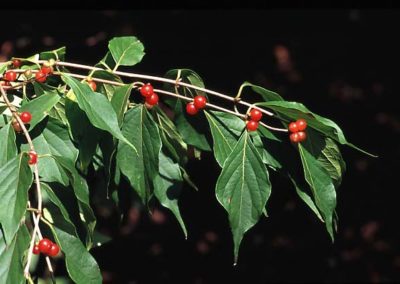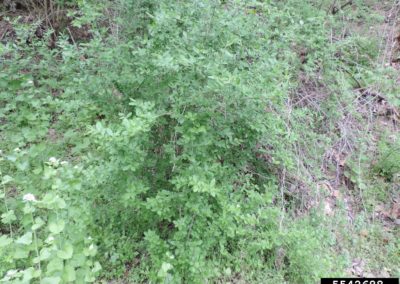Asian Bush Honeysuckle
Invasive Management Profile
Asian Bush Honeysuckle is among one of the fastest growing invasive species in Indianapolis. This species takes over forested areas, waterway banks, and backyards.
Identification
Asian bush honeysuckles (Lonicera maackii, L. morrowii, & L. tartarica) are upright shrubs 6-15 feet tall with arching branches. Each of these species has dark green egg-shaped leaves, with the tips of leaves pointed on Amur honeysuckle. They stand out in the understory of forests as the first shrubs to leaf out in the spring and the last to lose leaves in the fall. The paired, tubular flowers are white on Amur and Morrow honeysuckle and pink on Tartarian honeysuckle, and the flowers have a pleasant aroma, which has made it popular among homeowners. The berries are produced in the fall and range from red to orange, they are eaten and dispersed by birds.
Tools & Supplies Needed
- Shovel and/or spade
- Handsaw and/or lopper
- Protective eyewear, gloves, and clothing
- Paper or plastic bags for disposal
Removal Methods
Asian Bush Honeysuckle is a relatively shallow rooted plant, so small sapling shrubs can often be pulled from the ground without much difficulty. It’s important that these small, hand-pulled shrubs are removed from the landscape as they can re-root if left in contact with the soil.
STEP 1 : Identify plant using our identification tips and photos as well as the time of year and growth stage.
STEP 2 : Wear protective eyewear, gloves, and clothing.
STEP 3 : Use your hand to grab the bottom of the plant, twist, and pull.
STEP 4 : When pulling, make sure to remove the taproot, which is the main root system (this may be easily removed with a spade or shovel as well).
STEP 5 : Make sure to place all plant debris into a paper or plastic bag to control seed spread.
Larger Honeysuckle is more difficult to manage and the preferred method of control is the “cut-stump” treatment method.
STEP 1 : Identify plant using our identification tips and photos as well as the time of year and growth stage.
STEP 2 : Wear protective eyewear, gloves, and clothing.
STEP 3 : Using a handsaw or a pair of loppers, cut the Honeysuckle bush as low to the ground as possible.
STEP 4 : If possible, use a strong formulation of herbicide (~40-50% solution of either glyphosate or triclopyr) to directly spray or “paint” the stump. If you choose to use herbicide to treat Asian Bush Honeysuckle, click here to learn more about safe herbicide use.
STEP 5 : Make sure to place all plant debris into a paper or plastic bag to control seed spread.
STEP 6 : The initial cut-stump treatment may not always be 100% effective, so it is important to continue monitoring your removal site and re-treat any new Honeysuckle growth as it occurs. There will likely be Honeysuckle seeds in the soil or new seeds may be delivered by birds, so take care to pull new Honeysuckle growth before it becomes more difficult to control.
Disposal
Figuring out a way to dispose of the removed Asian Bush Honeysuckle can be the trickiest task in invasive species management, particularly if the Honeysuckle is large and a lot was removed. Small sapling shrubs can be disposed of in the trash and will be picked up through regular trash collection. Large Honeysuckle shrubs can be picked up through the city’s heavy trash collection provided they are tied into bundles no larger than 3 feet by 3 feet. Heavy trash collection guidelines and monthly pick-up days for your address can be found here.
Beyond trash collection services, you may need to either hire someone to come and remove the yard waste generated from your Honeysuckle removal or haul the waste away yourself. Many landscaping companies will accept yard waste for a small cost. They then process this material into mulch or compost. Click here to learn more about tree removal services in your area.
Native Alternative Species
To learn more about natives and how to landscape with them click here.
Nannyberry (Viburnum lentago)
|
Growth Type: Deciduous shrub
Height: 14 to 16 feet
Spread: 6 to 12 feet
Bloom Time & Description: May; showy white flower
Fruit: Showy, Edible
Light exposure: Full sun to part shade
Attracts: Birds, Butterflies
Tolerate: Air Pollution
|
Photo Courtesy of The City if Indianapolis Land Stwardship |




